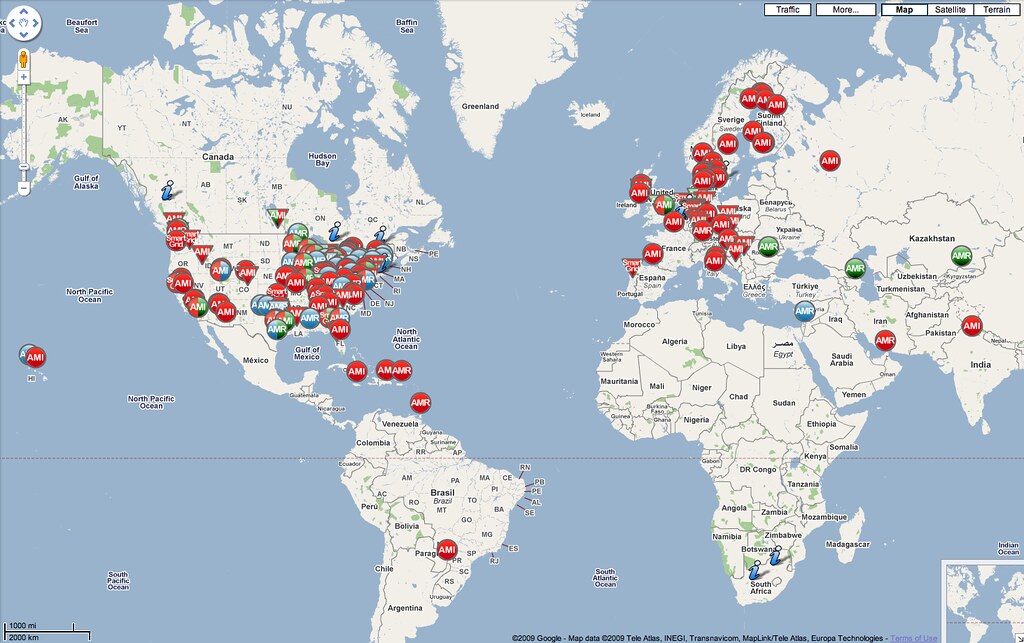
This is a map of current smart meter/smart grid projects globally overlaid on Google maps.
Screenshot credit Me(!)
I wrote my first Greenmonk post about Smart Grids and Demand Response back in April 2008 and followed up with a few more in the next few weeks including one in June 2008 where I said the electrical distribution system needed to be more like the Internet. Those posts were extremely cutting edge at the time but the world has caught up considerably in the last 18 months due in no small part to the election of Barack Obama and the focus on energy efficiency in his stimulus package!
Under Obama’s administration the US Dept of Energy announced in June of this year the rules for $3.9billion in Smart Grid stimulus grants. The first winners of $3.9 billion in smart grid stimulus grants will be announced in mid-November according to DOE deputy press secretary Jen Stutsman.
In a very positive move earlier this week, US Energy Secretary Steven Chu endorsed the importance of Demand Response as part of the solution when he said that electricity costs should move to reflect demand. Secretary Chu went further though arguing for the kind of automated Demand Response we have proposed here on GreenMonk when he said:
“Price signals do matter, but you can’t just simply use a price signal,” Chu said. “You really have to make it very easy to save energy.”
Consumers need to have a very simple system that will provide them with specific information about their energy use and they should be able to adjust their appliances so that they run mostly during non-peak energy hours
Adrian Tuck, CEO of Tendril announced last week that mass market home energy management is three years away. Obviously, being the CEO of a company in the space, he would say that, wouldn’t he? But looking at the slew of announcements which came out of the Gridweek conference (see below) it is hard to fault his optimism.
And just yesterday U.S. Commerce Secretary Gary Locke and the National Institute of Standards and Technology (NIST) presented for public comment a major new report on Smart Grid interoperability standards. The approximately 90-page document [pdf] identifies about 80 initial standards that will enable the vast number of interconnected devices and systems that will make up the US Smart Grid to communicate and work with each other.
You know that the administration is taking Smart Grids seriously when the Commerce Secretary presents for public comment a report on standards!
This week saw the GridWeek conference happening in Washington DC and with it a massive slew of Smart Grid related news. I’ll try to do a quick round-up of the main stories:
Partnerships
- Landis+Gyr, in cooperation with SAP, brings utilities closer to an interoperable Smart Grid
- Siemens, Silver Spring announce Smart Grid interoperability
- Cisco recruits Smart Grid players into interoperable consortium – covered here and here
- Trilliant, ABB partner to make Smart Grid technologies interoperable
- Elster partners with Blue Line, Augusta to beef up its Smart Grid offerings
- Itron teams with OpenPeak to bring smart meter data to touchscreens
Acquisitions
- Siemens acquires majority stake in Energy4U
- Silver Spring Networks gobbles up Greenbox to become Smart Grid powerhouse
Smart Cities
- The City of Austin Selects Oracle® Utilities Customer Care and Billing to Support Smart Grid Initiatives
- Boulder’s Smart Grid City Goes (Mostly) Live
- San Jose, PG&E lift veil on major Smart Grid collaboration
Launch
Other Announcements
With finance, administration backing and so many announcements (many of which are worthy of blog posts in their own right) there is no doubt but that the Smart Grid train has well and truly left the station. There are still a significant number of issues to be addressed by companies involved in the Smart Grid space. Some companies will founder, some deployments will fail (esp as utilities are notoriously bad at customer communications!) but there is no doubt that finally the Electricity 2.0 revolution has begun – there’s no turning back now.



